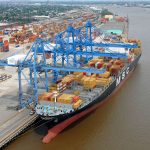Are Automated Freight Forwarders Better for Shippers?
![]() Freight forwarders and non-vessel operators (NVOs) have been under a great deal of scrutiny for their lack of automation lately.
Freight forwarders and non-vessel operators (NVOs) have been under a great deal of scrutiny for their lack of automation lately.
For anything consumers want, they can go online and with a few clicks see a price to make it theirs. Often, it only takes one more click to actually buy it. This works for anything it seems except the service of importing and exporting goods.
When it comes to shipping goods, especially ocean freight but with air freight as well, consumers have to contact a company, communicate with a real live person, and then wait for that person to get back to them with a quote for their shipment.
Why can’t there just be an instant quote for international shipping? An app on the phone that tells you how much it will cost to import or export your goods in a matter of seconds and then let you click “buy” and be done with it?
A recent article by Hugh R. Morley in the Journal of Commerce (JOC) says:
Many of the 20 largest freight forwarders have only a basic, undeveloped portal through which to provide door-to-door shipping prices and enable customers to make bookings online, if any portal at all, according to a report released Thursday by Freightos.
Of course, Freightos’ report is a self-serving one. After all, the company is a new freight forwarding service offering automated freight quotes.
Self-serving or not, the report does bring up what is quickly becoming a sore spot for freight forwarders and NVOCCs. Shippers who are now coming onto the scene grew up with computers and smart phones allowing them to buy anything they want with a click of the button. Why can’t freight forwarders make the complicated business of international shipping this simple?
The answer is that shipping goods from one country to another utilizing multiple modes of transportation and dealing with differing laws and lots of potential complications is not as simple as buying a dress online.
Negotiating with ocean carriers and agents around the world, rerouting because of labor strikes at ports or weather issues, knowing the changing rules and laws of customs clearance from country to country, handling complications that very commonly arise, avoiding unnecessary fees, knowing how to insure various types of cargo… I feel much more confident with a human being who has expertise in international shipping walking me through all this and more than a computer spitting out a price from an algorithm.
That doesn’t change the fact that international shipping headlines along with online platform companies like Amazon and Alibaba pushing into international shipping seem to be creating a threat, warning freight forwarders to update to automated systems or become obsolete.
In an industry as volatile as international shipping, however, the freight forwarder is still needed and beneficial in the constantly fluctuating spot rate market of international shipping. That begs the question of whether an automated freight forwarders would even be better for consumers.
While negotiating rates on behalf of consumers cannot be done by a machine, there certainly is elevated convenience and speed for shippers if accurate freight rates can be obtained through “instant” automated shipping tools.
Perhaps that convenience is enough to outdate the traditional freight forwarder.
Freight forwarder employee Kate McCauley, in a recent article published on The Loadstar, argues that the new automated marketplace tools for international shipping are far from outdating the traditional freight forwarder with a personal anecdote:
I’ve now tried three of the very publicly heralded freight marketplaces, promising to revolutionise global shipping bookings.
I entered a FOB 40ft Container from Shanghai to Felixstowe, one of the biggest trade lanes in the world. I was hoping for a plethora of choice and super-competitive rates. Quaking in my boots (thinking about my redundancy pay-out) I waited for the results to load – only to be greeted with ‘your route cannot be found, sorry no rates found, no results found.’ I couldn’t even enter a destination on one site. Was I doing something wrong?
And if I’m feeling like this, imagine what a first-time importer would think?
Maybe the freight marketplaces should change their slogans to “making global freight rates so transparent they can’t even be seen.”
Still, the tech industry is trying to dive into the international shipping industry because it seems like the last untapped market for purchasing automation. However, without the experience in this complex business, Silicon Valley is finding it more difficult than expected.
The tech industry is missing the experience and relationships to make automated international shipping marketplaces reliable, and freight forwarders are missing the resources to provide consumers with this convenience technology.
That doesn’t change the inevitability of automated marketplaces for international shipping; however, in my opinoin, what is needed is a marriage between the technological know-how and resources of the tech industry with the experience and friendly expertise of the freight forwarder.
While appeasing the demand for the industry to move in the speedy automated direction, it’s important the relationships shippers have with the experts negotiating international waters for them should not be left behind in the process.



